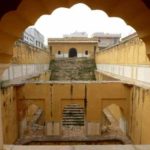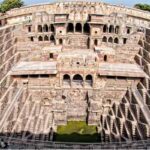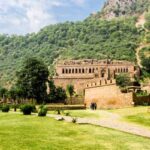Famous Stepwells in Rajasthan, known for its arid climate, boasts several famous stepwells, ingeniously designed structures that serve both practical and aesthetic purposes.
One of the most renowned stepwells is the Chand Baori in Abhaneri, near Jaipur. Dating back to the 8th-9th century, it is one of the largest and deepest stepwells in India, featuring 3,500 narrow steps over 13 stories, descending approximately 100 feet. Its geometric precision and symmetry are mesmerizing, making it a popular tourist attraction.
Another significant stepwell is the Panna Meena ka Kund in Jaipur. Built in the 16th century, it is a smaller, more intimate stepwell known for its picturesque beauty and precise geometric design. Its unique construction allowed villagers to descend for water, regardless of the water level.
In Jodhpur, the Toorji Ka Jhalra or Toorji’s Stepwell, built in the 1740s, reflects the grandeur of the Marwar region. Restored in recent years, it is now a cultural hub surrounded by cafes and shops, highlighting the blend of historical architecture with modern use, Famous Stepwells in Rajasthan.
These stepwells not only provided water but also acted as social gathering spots, showcasing Rajasthan’s architectural ingenuity and cultural heritage.
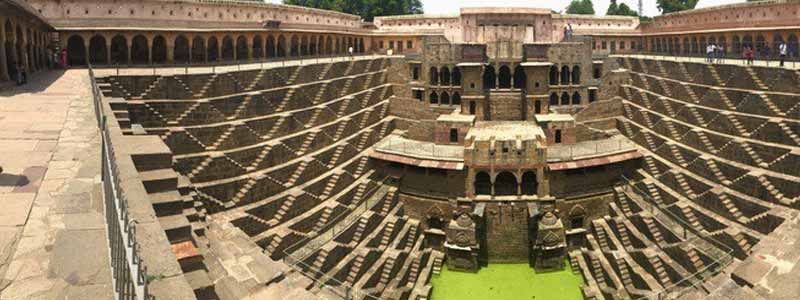
Chand Baori
Location: Abhaneri, near Jaipur
Features: One of the deepest and largest stepwells in India, it features 3,500 narrow steps over 13 stories. Built in the 9th century by King Chanda of the Nikumbha Dynasty, Chand Baori is renowned for its precise geometrical patterns and intricate carvings.
Chand Baori is one of the most famous and spectacular stepwells in Rajasthan, located in the village of Abhaneri, near Jaipur. Constructed in the 8th-9th century by King Chanda of the Nikumbh dynasty, Chand Baori is renowned for its intricate design and impressive scale.
This stepwell is one of the deepest and largest in India, featuring 3,500 narrow steps arranged in perfect symmetry, descending 13 stories to a depth of about 100 feet. The steps form a geometric maze, creating a striking visual effect that attracts architects, photographers, and tourists from around the world.
Chand Baori was not only a practical solution for water scarcity in the arid region but also served as a community gathering place, offering a cool respite from the desert heat. Adjacent to the stepwell is the Harshat Mata Temple, adding a spiritual dimension to the site.
The architectural brilliance of Chand Baori, with its precise symmetry and grandeur, exemplifies the ingenuity of ancient Indian engineering and stands as a testament to the region’s rich historical and cultural heritage, Famous Stepwells in Rajasthan.
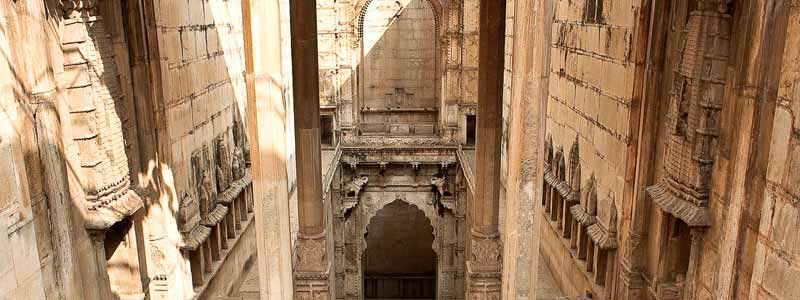
Rani Ji Ki Baori (Queen’s Stepwell)
Location: Bundi
Features: Built in 1699 by Rani Nathavati Ji, the stepwell is a fine example of ornate architecture. It features intricate carvings of gods and goddesses on its pillars and walls, showcasing Bundi’s rich heritage.
Rani Ji Ki Baori, also known as the Queen’s Stepwell, is a notable stepwell located in the town of Bundi, Rajasthan. Built in 1699 by Rani Nathavati Ji, the queen of Rao Raja Anirudh Singh, this stepwell is a striking example of the region’s architectural ingenuity and serves as a testament to the queen’s dedication to providing water for the people.
The stepwell is adorned with intricately carved pillars and high-arched gates, reflecting the grandeur and aesthetic sensibilities of the era. Its steps lead down to several levels, ensuring access to water even during dry periods. The walls are embellished with sculptures of deities, celestial beings, and geometric patterns, showcasing the artistic excellence of the craftsmen, Famous Stepwells in Rajasthan.
Rani Ji Ki Baori is not just a practical water reservoir but also a place of beauty and cultural significance. The stepwell’s design includes a combination of Mughal and Rajput architectural styles, making it a unique and important heritage site.
Today, Rani Ji Ki Baori remains a popular tourist attraction in Bundi, drawing visitors who admire its historical significance and architectural splendor. Its preservation and continued admiration highlight the importance of water conservation methods employed by ancient Indian societies and the artistic legacy of Rajasthan.
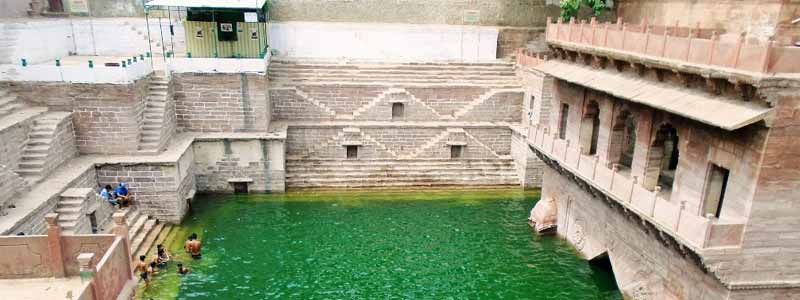
Toor Ji Ka Jhalra
Location: Jodhpur
Features: Constructed in the 1740s by a queen of Maharaja Abhay Singh, Toor Ji Ka Jhalra is a recently restored stepwell that now serves as a popular attraction in Jodhpur. It’s known for its impressive depth and the beautiful symmetry of its steps.
Toor Ji Ka Jhalra, also known as Toorji’s Stepwell, is a historic stepwell located in Jodhpur, Rajasthan. Constructed in the 1740s by a queen of Maharaja Abhay Singh, this stepwell exemplifies the architectural ingenuity and aesthetic sensibility of the period.
The stepwell descends through several levels with intricately carved steps, providing access to water throughout the year. The structure is adorned with beautifully carved pillars, niches, and statues, reflecting the grandeur of Marwar architecture. Unlike many other stepwells in the region, Toor Ji Ka Jhalra showcases a more simplistic yet elegant design, with an emphasis on functional beauty.
For many years, the stepwell fell into disuse and disrepair, becoming clogged with debris. However, a restoration project in recent years revitalized Toor Ji Ka Jhalra, clearing it of rubble and reviving its historical charm. This restoration has transformed the stepwell into a vibrant social space, surrounded by trendy cafes and shops, making it a popular spot for both locals and tourists, Famous Stepwells in Rajasthan.
Toor Ji Ka Jhalra stands as a testament to the engineering prowess and cultural heritage of Jodhpur, illustrating the critical role of water management in the arid landscape of Rajasthan. Its successful restoration highlights the importance of preserving historical structures for future generations to appreciate and enjoy.
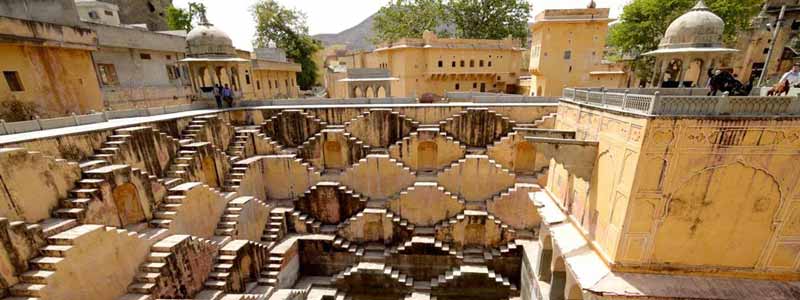
Panna Meena Ka Kund
Location: Amer, near Jaipur
Features: Built in the 16th century, this stepwell is known for its picturesque layout and the symmetry of its steps. It served both as a water reservoir and a community gathering place.
Panna Meena Ka Kund is a historical stepwell located in Jaipur, Rajasthan. Situated near the Amber Fort, this stepwell dates back to the 16th century and is a fine example of the traditional water management systems used in the region.
The design of Panna Meena Ka Kund is particularly striking, characterized by its perfectly symmetrical steps that form a geometric pattern. These steps not only provided access to water but also created a visually stunning architectural feature. The stepwell’s rectangular shape, with steps on three sides and a fourth side housing a pavilion, demonstrates a blend of practicality and aesthetic appeal.
Panna Meena Ka Kund was more than just a water reservoir; it was a communal gathering place where villagers would come to fetch water, bathe, and socialize. The cool environment of the stepwell offered a respite from the heat, making it a popular spot for relaxation, Famous Stepwells in Rajasthan.
The stepwell’s construction reflects the advanced engineering skills of the time, designed to ensure water availability throughout the year. Its preservation today allows visitors to appreciate the historical and cultural significance of such structures in Rajasthan.
Panna Meena Ka Kund remains a popular attraction for tourists and photographers, who are drawn to its unique design and serene ambiance. It stands as a testament to the ingenuity and resourcefulness of the people who built it, highlighting the importance of water conservation in the arid landscape of Rajasthan.
Hadi Rani Ki Baori
Location: Todaraisingh, near Tonk
Features: Built in the 17th century, this stepwell is noted for its elaborate and decorative architecture. It has seven stories with beautifully carved sculptures and niches.
Hadi Rani Ki Baori is a notable stepwell located in Tonk, Rajasthan. This stepwell is named after the legendary Hadi Rani, a queen known for her beauty and valiant spirit, symbolizing the rich cultural and historical heritage of the region.
Constructed in the 17th century, Hadi Rani Ki Baori is a striking example of the intricate architectural design and engineering prowess of the period. The stepwell is characterized by its deep well, surrounded by multiple levels of steps that descend gracefully into the water below. The steps are adorned with ornate carvings and decorative elements, showcasing the artistic excellence of the craftsmen of that era.
The structure served a crucial purpose in the arid region of Tonk, providing a reliable water source for the local community. The stepwell also acted as a social hub, where people would gather to fetch water, bathe, and socialize, creating a sense of community and connectivity.
The design of Hadi Rani Ki Baori reflects both practicality and aesthetic beauty, with its symmetrical steps and well-proportioned layout. The stepwell’s construction ensured that water was accessible even during dry periods, highlighting the importance of water management in Rajasthan’s history.
Today, Hadi Rani Ki Baori remains an important historical site, attracting tourists and history enthusiasts who marvel at its architectural splendor and historical significance. It stands as a testament to the innovative solutions and cultural richness of Rajasthan’s past, reminding visitors of the region’s enduring legacy of resilience and beauty, Famous Stepwells in Rajasthan.
Neemrana Baoli
Location: Neemrana, Alwar
Features: A grand structure with multiple levels of steps, the Neemrana Baoli is not only an architectural wonder but also a symbol of the region’s efforts to conserve water in historical times.
Neemrana Baoli is a historic stepwell located in the town of Neemrana in Alwar district, Rajasthan. Constructed in the early 18th century, this stepwell is a prime example of the traditional water management systems that were crucial in the arid regions of Rajasthan.
The Neemrana Baoli is renowned for its impressive depth and intricate design. It descends nine stories into the ground, with wide steps that lead down to the water reservoir at the bottom. The stepwell is adorned with beautifully carved arches, pillars, and balconies, reflecting the architectural style of the period. The symmetry and geometric precision of the steps create a visually captivating pattern, which is a hallmark of stepwell design, Famous Stepwells in Rajasthan.
Beyond its practical function as a water source, the Neemrana Baoli also served as a social and communal space where villagers would gather for various activities. The cool environment provided by the deep well offered a respite from the intense heat, making it a popular spot for relaxation and socialization.
The architectural brilliance of Neemrana Baoli, combined with its historical significance, makes it a fascinating site for tourists and history enthusiasts. Its restoration and preservation efforts highlight the importance of maintaining such historical structures, which offer a glimpse into the innovative water management techniques and cultural heritage of Rajasthan.
Today, Neemrana Baoli stands as a testament to the ingenuity and resourcefulness of its builders, embodying the blend of utility and beauty that characterizes many of Rajasthan’s ancient structures.
Nagaur Baoris
Location: Nagaur
Features: Nagaur is home to several baoris (stepwells), with the most notable being the impressive and intricately designed baori near the fort. These stepwells highlight the medieval water management system in the region.
Nagaur Baoris, also known as the stepwells of Nagaur, are a series of remarkable stepwells located in Nagaur district, Rajasthan. Nagaur is known for its historical significance and architectural heritage, and the baoris are among its prominent attractions.
These stepwells were built during the medieval period to address the water needs of the region and also served as social and community gathering places. Though not as well-known as some of Rajasthan’s other stepwells, Nagaur Baoris possess their own unique charm and historical importance.
One notable baori in Nagaur is the Hadi Rani Ki Baori, named after Hadi Rani, the legendary queen known for her bravery and sacrifice. This baori features a deep well with intricate steps leading down to the water level. The architecture is adorned with carvings and ornamental designs, reflecting the artistic flair of the time, Famous Stepwells in Rajasthan.
Another significant baori is the Nawal Sagar Baori, known for its large size and elaborate design. It served as a major water source for the town and showcases the engineering skills of the builders.
While these baoris may not attract as many tourists as those in other cities like Jaipur or Jodhpur, they hold immense historical and cultural value for the region. They stand as silent witnesses to the bygone era, reflecting the architectural brilliance and water management techniques of ancient Rajasthan.
Exploring Nagaur Baoris offers visitors a glimpse into the rich heritage and ingenuity of the people who inhabited this region centuries ago, making them an essential part of Rajasthan’s historical narrative.
Bhandarej Baori – Famous Stepwells in Rajasthan
Location: Bhandarej, near Dausa
Features: Known for its ancient and elaborate architecture, the Bhandarej Baori is a significant historical stepwell with ornate designs.
Bhandarej Baori, located in Dausa district, Rajasthan, is a lesser-known but historically significant stepwell in the region. Dating back to the 8th-9th century, this stepwell showcases the architectural prowess and water conservation techniques of ancient Rajasthan.
Bhandarej Baori is characterized by its simple yet elegant design. It consists of a rectangular well with steps leading down to the water level. The stepwell is adorned with intricately carved pillars and arches, though its architectural embellishments are relatively understated compared to some other stepwells in Rajasthan.
Despite its simplicity, Bhandarej Baori served as a vital water source for the surrounding area, particularly during the dry seasons. It provided water not only for drinking and household use but also for irrigation, sustaining agriculture in the region.
What makes Bhandarej Baori unique is its tranquil setting amidst the rural landscape of Dausa. Surrounded by fields and trees, the stepwell offers a peaceful retreat from the bustling city life, making it a serene spot for visitors to explore and relax.
While Bhandarej Baori may not be as grand or well-known as some of Rajasthan’s other stepwells, it holds immense historical and cultural significance. It stands as a testament to the ancient water management practices and architectural heritage of the region, offering insight into the daily life and challenges faced by people in ancient times, Famous Stepwells in Rajasthan.

